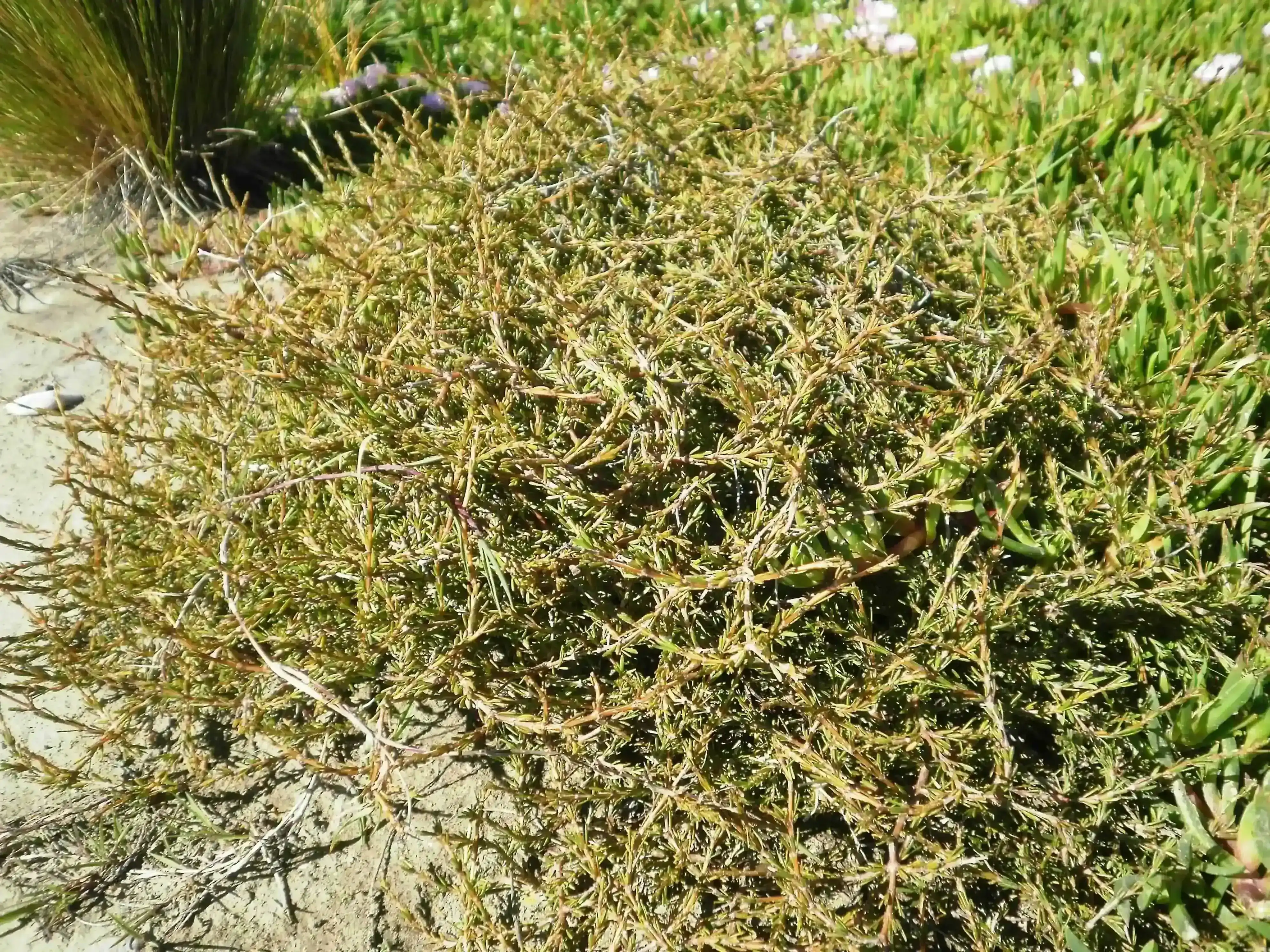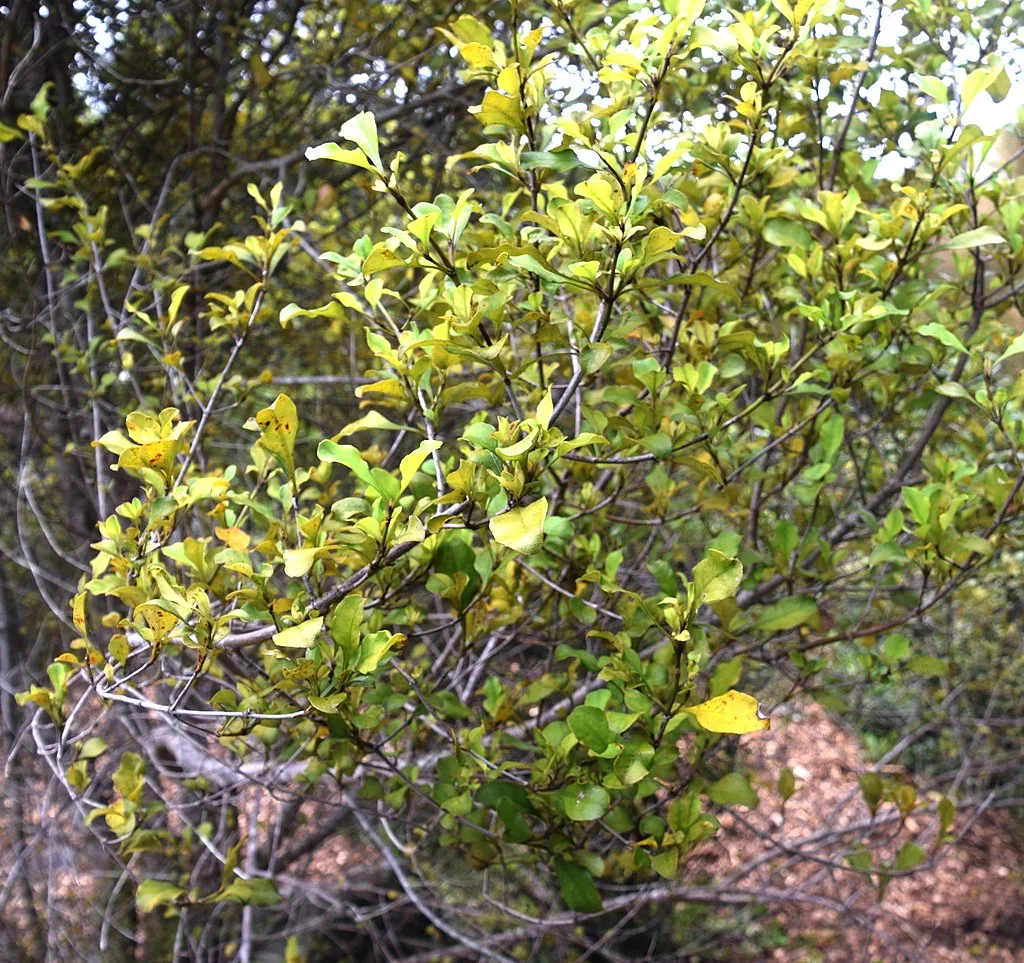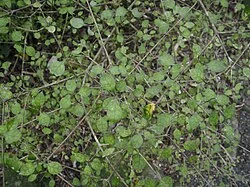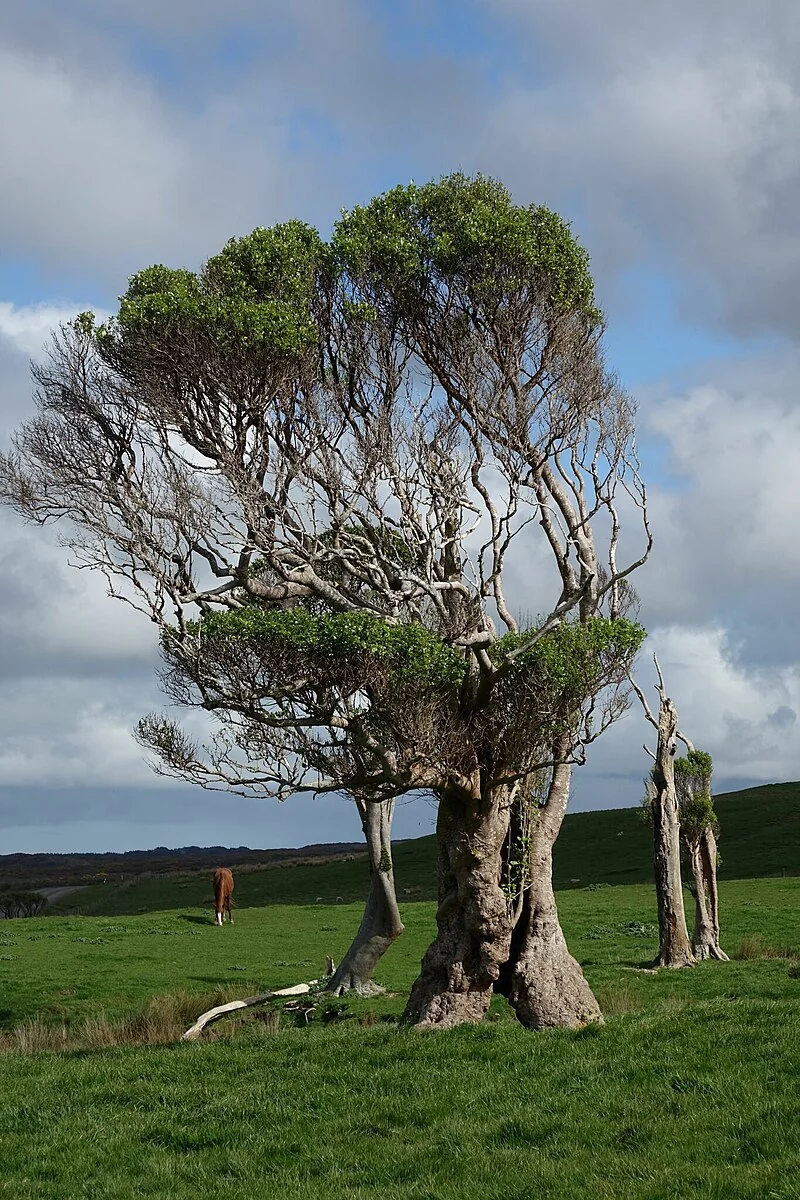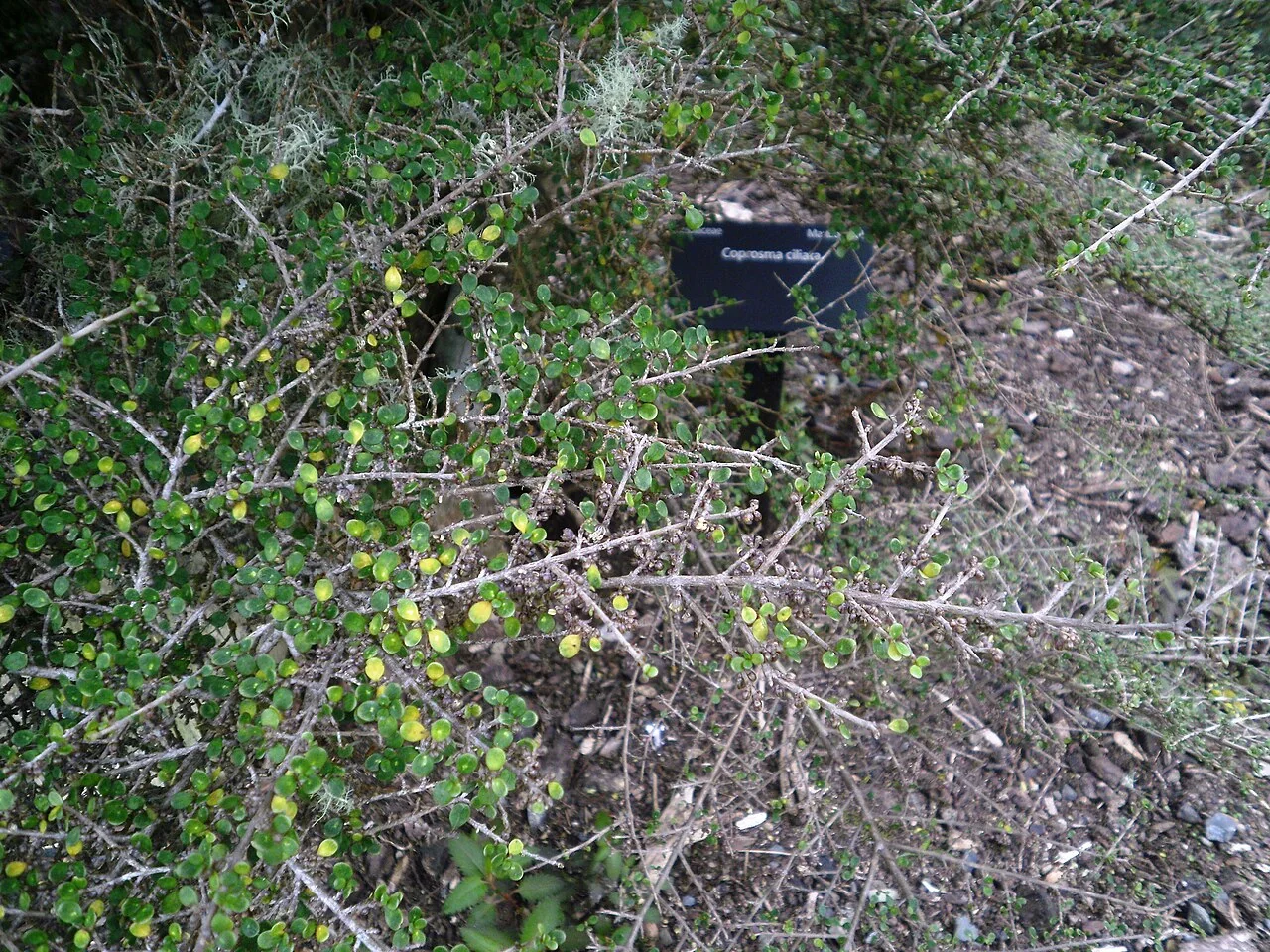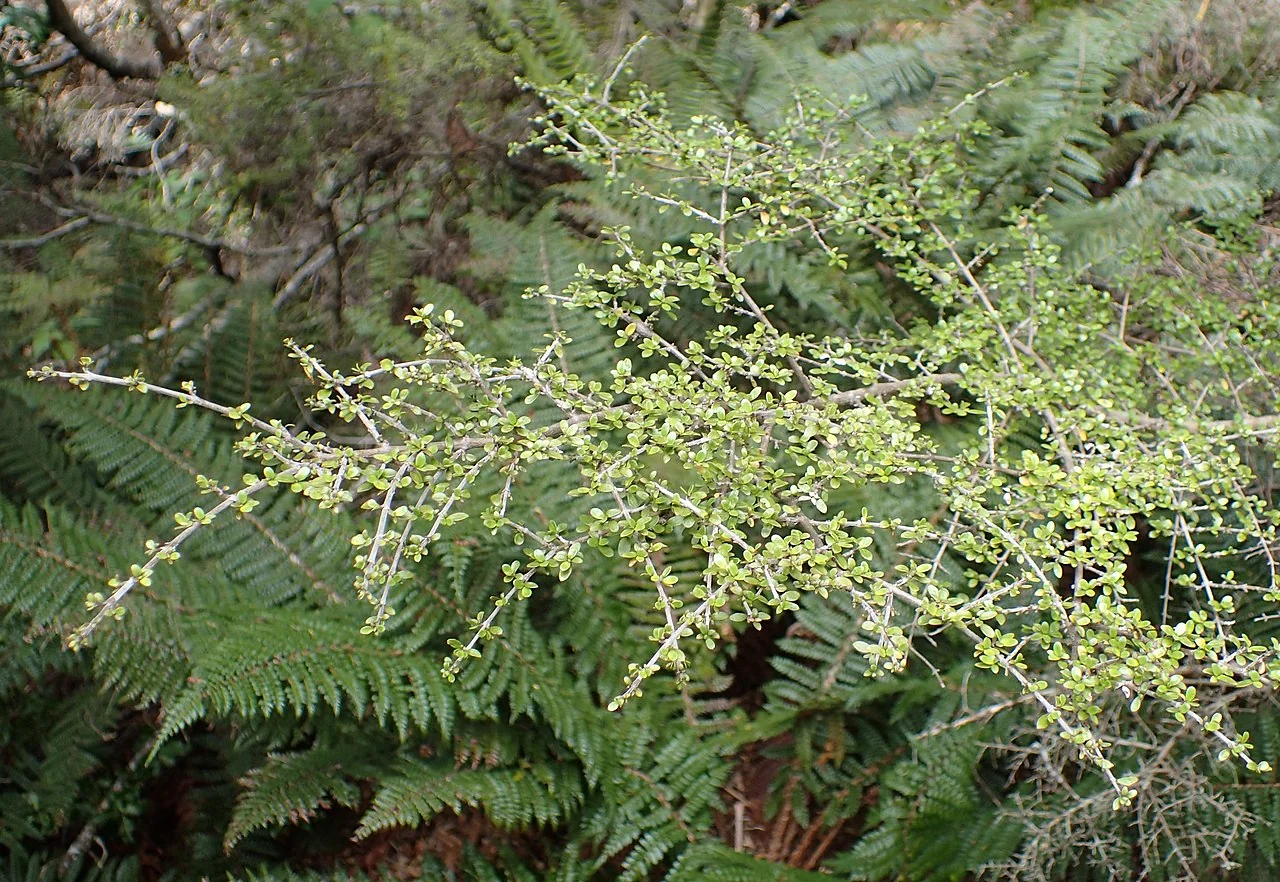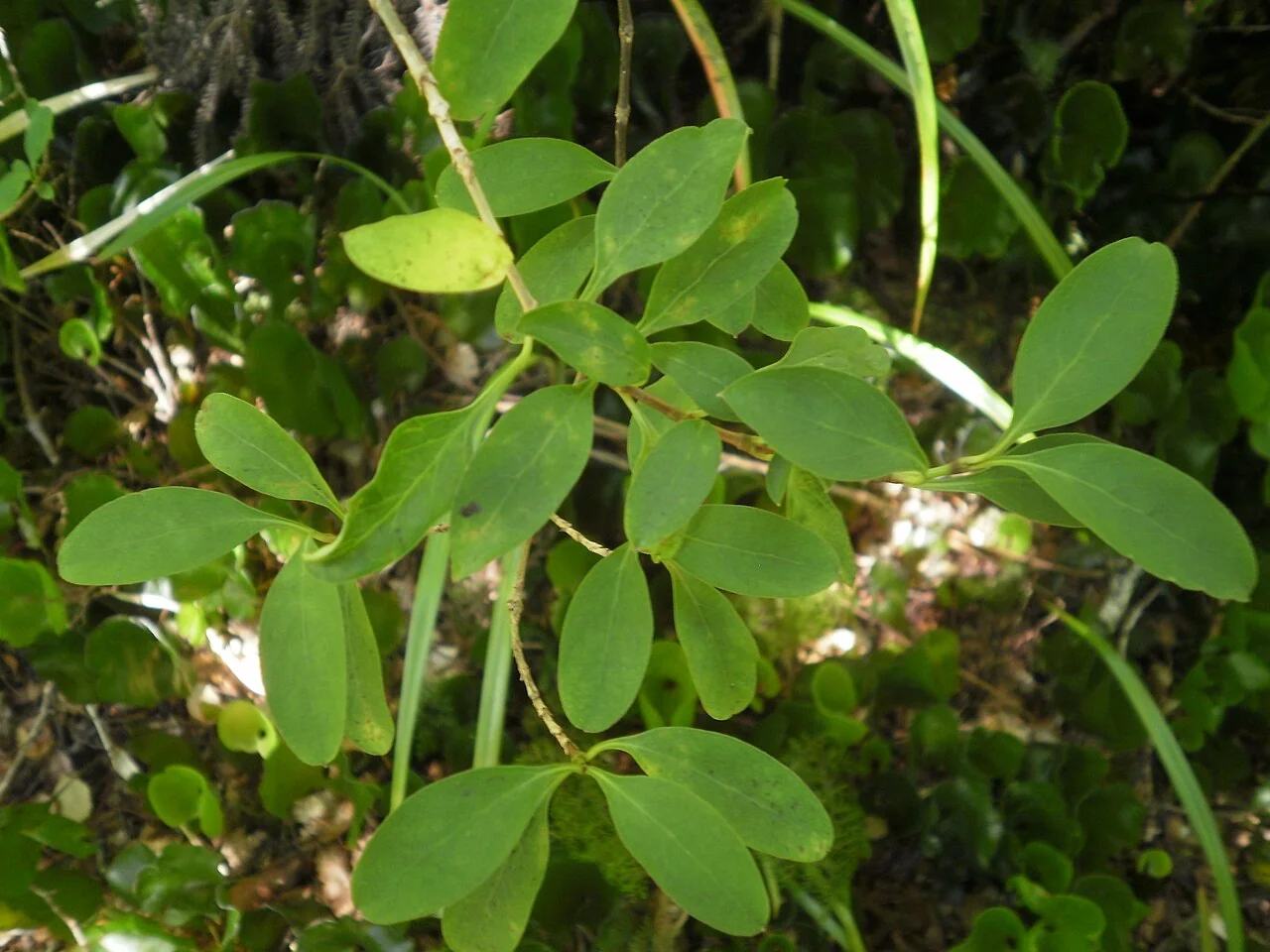
Karamā
Coprosma robusta
Karamā ( Coprosma robusta ) stands as one of New Zealand's most recognizable and ecologically valuable native shrubs , distinguished by its remarkably large, glossy leaves and prolific displays of bright orange berries. This robust member of the Rubiaceae family typically grows 3-6 meters tall, forming dense, spreading canopies that provide essential habitat structure in forest ecosystems. The species is renowned for its extraordinary fruit production - masses of translucent orange drupes cluster densely along the branches, creating spectacular autumn displays while serving as a critical food source for native and introduced birds. Its broad, leathery leaves, measuring 7-15 cm in length, display a distinctive glossy dark green surface with prominent pale midribs, making them easily distinguishable from other Coprosma species. Found naturally in lowland to montane forests throughout New Zealand, Karamā thrives in forest margins, clearings, and regenerating areas where its fast growth and prolific seeding enable rapid colonization. The plant's dioecious nature means male and female flowers occur on separate plants, with female plants producing the characteristic berry displays that make this species so valuable for wildlife. Beyond its ecological importance, Karamā holds significant cultural value in Māori tradition, where both the berries and leaves were utilized for food and medicine, reflecting the deep connection between indigenous people and their native flora.

Plant Description
Botanical Features
Coprosma robusta , commonly known as Karamā, is a robust and versatile evergreen shrub or small tree endemic to New Zealand. It can grow up to 6 meters tall, with numerous stout, erect to spreading branches. It is distinguished by its remarkably large, glossy, leathery leaves, typically 7-12 cm long, which are dark green above and paler green beneath, with a prominent midrib. Small, dark-tipped stipules are present at the base of the leaf stalks. The plant produces small, inconspicuous green or white flowers, followed by abundant bright orange to dark orange-red berries (drupes) in tight clusters along the twigs. These berries are a critical food source for native birds. It is commonly found in coastal areas, lowland forests, and shrublands throughout New Zealand, thriving in well-drained soils and tolerating a wide range of conditions.
Quick Facts
| Scientific Name | Coprosma Robusta |
|---|---|
| Height | 3-6 m |
| Spread | 2-4 m |
| Water Needs | Moderate |
| Light | Full sun to part shade |
| Frost Tolerance | Moderate |
| Salt Tolerance | Moderate |
| Growth Rate | Fast |
| Lifespan | Long |
Climate Best Suited to
Karamū ( Coprosma robusta ) thrives across New Zealand in various conditions, from coastal to inland areas with consistent moisture. It adapts well to typical New Zealand growing conditions with appropriate care and positioning.
Regional Suitability
| Whangārei | Ideal |
| Auckland | Ideal |
| Hamilton | Suitable |
| Rotorua | Suitable |
| Tauranga | Ideal |
| Gisborne | Ideal |
| New Plymouth | Ideal |
| Whanganui | Ideal |
| Palmerston North | Suitable |
| Napier | Ideal |
| Wellington | Ideal |
| Nelson | Ideal |
| Christchurch | Suitable |
| Dunedin | Suitable |
| Invercargill | Suitable |
| City | Climate Suitability |
|---|
Natural Habitat
Karamā ( Coprosma robusta ) is one of New Zealand's most widespread and adaptable native shrubs, thriving in a diverse range of habitats across the North, South, and Stewart Islands. It is a common sight in lowland and lower montane areas, typically found in forest margins, regenerating scrubland, and open sites within forests. As a hardy pioneer species, it is often one of the first plants to colonize disturbed land, making it a crucial player in forest regeneration. Its tolerance for a wide variety of conditions allows it to grow in everything from coastal areas, where it can withstand some salt spray, to inland forests and shrublands. While it prefers moist, well-drained soils, it can also be found in wetter areas, including the margins of wetlands and swamps. This adaptability, combined with its fast growth rate, makes Karamā a familiar and vital part of New Zealand's natural landscape.
Plant Conservation
Coprosma robusta , also known as karamū, is currently classified as "Not Threatened" in New Zealand. While it is widespread and common in various habitats across New Zealand, some regional classifications may list it as "At Risk - naturally Uncommon." However, the national conservation status indicates it is not considered a threatened species.
Growing Requirements
Soil Requirements
Karamū ( Coprosma robusta ) performs best in well-draining soil that retains adequate moisture. Like most New Zealand natives, it prefers soils that don't become waterlogged but maintain consistent moisture levels. Good drainage is essential for healthy root development.
- Well-draining soil essential for healthy growth
- Prefers consistent moisture without waterlogging
- Adapts to various soil types with good drainage
- Benefits from organic matter incorporation
- Mulching helps retain moisture and suppress weeds
Light Requirements
Karamū ( Coprosma robusta ) performs well in full sun to partial shade conditions. Like many New Zealand natives, it adapts to various light conditions but typically shows best growth and form in positions that receive adequate sunlight throughout the day.
- Full sun to partial shade positions
- At least 4-6 hours of direct sunlight daily
- Tolerates light shade in warmer climates
- Morning sun particularly beneficial
Water Requirements
Karamū ( Coprosma robusta ) requires regular watering during establishment, typically for the first 1-2 years. Once established, it becomes more drought-tolerant but benefits from consistent moisture during dry periods. Avoid overwatering which can lead to root problems.
- Regular watering during establishment phase
- Moderate drought tolerance once established
- Consistent moisture during dry periods beneficial
- Avoid waterlogged conditions
- Mulching helps conserve soil moisture
Planting Guide
When to Plant
Plant Coprosma robusta from spring through autumn when soil conditions are suitable.
Site Selection and Soil
- Sunlight: Karamū is adaptable and thrives in full sun but can also tolerate partial shade.
- Soil: It prefers well-drained soil and can grow in a variety of soil types, including light (sandy) and medium (loamy) soils. It tolerates infertile soils and prefers neutral to slightly acidic pH.
- Climate: This plant is extremely hardy and can withstand a wide range of environmental conditions, including frost, wind, and dry or moist sites. It is commonly found in coastal areas.
Planting Steps
- Dig a hole twice the depth and width of the plant's root ball.
- Mix compost and sheep pellets into your existing soil at a 50/50 ratio.
- Backfill the hole so that the top of the plant's roots are level with the surrounding ground.
- In heavy clay soils with drainage issues, plant onto a raised mound and add gypsum clay breaker to the bottom of the hole to help condition the soil.
- Water in well with an organic garden booster.
After Planting Care
Water deeply after planting to settle the soil around the roots. Keep the soil moist for several weeks until the plant establishes. Once established, it is relatively drought-tolerant but performs better with consistent soil moisture during the growing season. Mulching can help retain soil moisture.
Ecological Role
Environmental Benefits
Coprosma robusta , also known as Karamū, plays several significant ecological roles in New Zealand's ecosystems. It is a fast-growing, adaptable shrub or small tree native to New Zealand, found in various habitats including forests, shrublands, wetlands, and coastal areas.
- Food Source: The plant produces small, round berries that turn from green to red when ripe, serving as an important food source for native birds such as tūī, bellbirds, silvereyes, and fantails.
- Habitat and Shelter: Coprosma robusta provides habitat and shelter for native birds and insects.
- Soil Stabilization: It contributes to stabilizing soils, particularly in areas prone to erosion.
- Pioneer Species and Nurse Plant: As one of the earliest native colonizing species, it is widely used in revegetation, riparian planting, and native restoration projects. It acts as a "nurse crop" or "nurse plant," providing shelter for other native species and effectively competing with invasive species like gorse.
- Biodiversity Enhancement: Birds attracted to its berries help disperse seeds of other plant species through their droppings, thereby increasing overall biodiversity in an area.
Uses and Significance
Garden Uses
- Excellent for native plant gardens and restoration
- Suitable for naturalistic landscape designs
- Low maintenance once established
- Contributes to local biodiversity
- Attractive to beneficial native wildlife
Cultural Significance
Traditional Uses and Values
Coprosma robusta , commonly known as Karamū, holds significant cultural importance and has various traditional uses within Māori culture in New Zealand.
- Food Source: The ripe berries of Karamū were a traditional food for Māori, valued for their edible qualities and rich vitamin C content, which helped prevent scurvy. The leaves were also used to line hāngī (earth oven) pits, imparting flavor to food and aiding in its preservation.
- Medicinal Uses (Rongoā Māori): Karamū was a key plant in traditional Māori medicine (Rongoā Māori). Infusions made from its leaves were used to treat ailments such as kidney problems, bladder infections, and stomach issues. Externally, the leaves were applied to wounds and skin conditions. Boiled young shoots were consumed for bladder stoppage or inflammation, and the bark was used to address consumption (kohe or tarai).
- Tools and Weapons: The wood of the Karamū plant was utilized for crafting tools and weapons.
- Dye Production: Karamū contains natural dyeing properties, including alizarin and purpurin, which were extracted to dye flax fibers a yellow colour.
- Spiritual and Ceremonial Practices: The plant carries spiritual importance for Māori and was incorporated into various ceremonies. This included birthing ceremonies and funerary rites. Wands fashioned from Karamū branches were used in diagnosing illnesses, and green Karamū branches were held by tohunga (experts) during tohi ceremonies for newborns.
Landscaping Uses
Garden Design Applications
Coprosma robusta , commonly known as Karamū, is a highly versatile New Zealand native shrub or small tree with a wide range of landscaping uses, primarily due to its robust nature, fast growth, and ecological benefits.
- Native Revegetation and Ecological Restoration: It is a crucial "pioneer plant" for restoring degraded environments, stabilizing soil, and providing shelter for other native species. It also helps in combating invasive plants.
- Shelterbelts and Privacy Screening: Its fast-growing, upright habit makes it an excellent choice for creating effective windbreaks and privacy screens.
- Riparian and Wetland Margins: Coprosma robusta performs well in areas along waterways and wetlands.
- Wildlife Gardens: The plant's bright orange-red berries attract birds, making it a valuable addition to gardens designed to support local wildlife and increase biodiversity.
- Hedges and Background Plantings: It can be pruned to form hedges and serves as an attractive background shrub in mixed plantings due to its glossy green leaves and reddish stems.
- Coastal Gardens: Coprosma robusta is tolerant of wind and salt spray, thriving in coastal environments.
- Urban Green Spaces: It is adaptable to various climates and conditions, including full sun to partial shade, windy, and frosty environments, making it suitable for city parks and suburban gardens.
Seasonal Care Calendar
Spring
Spring is an active growth period for Karamū ( Coprosma robusta ). New growth emerges and this is an ideal time for planting new specimens. Monitor soil moisture as temperatures warm and growth accelerates.
- Active growth period with new foliage development
- Ideal time for planting new specimens
- Monitor soil moisture as temperatures rise
- Apply organic mulch if needed
Summer
Summer is typically the main growing season for Karamū ( Coprosma robusta ). Ensure adequate watering during hot, dry periods, especially for young plants. Established plants show good heat tolerance with appropriate care.
- Peak growing season with active development
- Monitor watering needs during hot weather
- Young plants need consistent moisture
- Established plants show good heat tolerance
Autumn
During autumn, Karamū ( Coprosma robusta ) begins to slow its growth as temperatures cool. This is another good time for planting as conditions become more favorable. Reduce watering frequency but maintain soil moisture.
- Growth slows as temperatures moderate
- Good time for planting new specimens
- Reduce watering frequency gradually
- Maintain soil moisture without overwatering
Winter
Winter is typically a dormant period for Karamū ( Coprosma robusta ), with minimal growth activity. Reduce watering but ensure plants don't completely dry out. Most New Zealand natives are cold-hardy and require minimal winter protection.
- Dormant period with minimal growth activity
- Reduce watering but avoid complete drying
- Generally cold-hardy in most New Zealand climates
- Minimal winter protection required
When to Prune and How Much
Karamū ( Coprosma robusta ) generally requires minimal pruning to maintain its natural form and health. Most maintenance involves removing dead or damaged growth and light shaping if needed.
- Remove dead, damaged, or diseased growth as needed
- Light pruning to maintain shape if desired
- Prune after flowering if applicable
- Avoid heavy pruning which can stress the plant
- Use clean, sharp tools to prevent disease
- Most natives maintain good form without regular pruning
Always use clean, sharp tools when pruning to minimize disease risk. Native plants typically maintain their natural form well and often require less intervention than exotic species.
How to Grow Karamā
Karamā ( Coprosma robusta ) is a remarkably resilient and fast-growing shrub, making it an excellent choice for gardeners of all skill levels. Its adaptability allows it to thrive in a wide range of conditions across New Zealand, from coastal areas to inland forests. To ensure your Karamā flourishes, follow these simple guidelines.
From Seed
Propagating Karamā from fresh seed is a viable method, though germination can be variable. Collect ripe berries in late autumn or early winter. Clean the seeds thoroughly to remove any fleshy pulp. Sow the seeds in a tray filled with a well-draining seed-raising mix, lightly covering them. Maintain consistent moisture in the seed tray and keep it in a warm, sheltered location. Germination can take several weeks to months. Once seedlings have developed a few true leaves, they can be potted into individual containers and grown in a sheltered environment before planting out.
From Cuttings
Semi-hardwood cuttings are a reliable method for propagating Karamā, ensuring that new plants retain the exact characteristics of the parent. Take 10-15 cm cuttings from healthy, semi-hardwood stems in late summer or early autumn. Remove the lower leaves and dip the cut end in a rooting hormone. Insert the cuttings into a well-draining propagation mix (e.g., sand and perlite). Keep the cuttings in a warm, humid environment, out of direct sunlight, perhaps under a plastic dome or in a propagator. Rooting typically occurs within 8-12 weeks. Once rooted, the new plants can be potted on and grown in a sheltered environment until they are ready for planting.
Pests and Diseases
Coprosma robusta , commonly known as karamū, is generally considered a robust plant that is largely pest- and disease-free. However, it can be affected by several issues:
Diseases:
- Root rot: Can occur in poorly drained soils.
- Coprosma lethal decline: Caused by "Candidatus Phytoplasma australiense," is associated with symptoms such as leaf reddening or bronzing, interveinal chlorosis, abnormal leaf yellowing, slowed growth, and dieback of shoots and branches.
- Leaf spot disease: Often identified as Mycosphaerella coacervata or its anamorph Phyllosticta coprosmae, causes purple blotches on the leaves.
- Nematode: Litylenchus coprosma can cause angular yellow patches on the leaves.
- Rust: Manifests as pale yellow circular or irregular spots on the underside of leaves, which turn yellow on the upper surface and eventually brown, with brown/black rust structures developing underneath.
- Algal leaf spot: Appears as slightly raised, greenish-white to yellow circular spots on the upper leaf surface, with corresponding brown spots on the underside.
- Rhizoctonia solani: Can cause crown and root rot.
Pests:
- Herbivorous mammals: Like goats and deer can severely impact karamū, while hares and rabbits consume seedlings.
- Insects: Various insects, including Batracomorphus, Batracomorphus adventitiosus, leafhoppers, and Membracoidea, feed on the plant.
- Thrips: Damage plants by sucking juices and scraping at fruits, flowers, and leaves, which can lead to leaf death.
- Coprosma white erineum mite (Phyllocoptes coprosmae): Induces white hairs (erineum) on the underside of leaves, and sometimes on the upper surface, potentially causing yellowing (chlorosis) on the upper side of the leaf above the affected area.
Bonus Tip
Expert Growing Advice
Karamū is a vital "nurse plant" in regeneration projects. Its fast growth and dense foliage provide shelter for other, more slow-growing native species, protecting them from the elements and browsing animals. This makes it an essential tool for restoring New Zealand's native forests.
